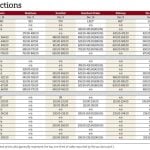Chicago | Reuters—Chicago soybean futures rose on Friday, driven by short-covering ahead of the weekend and technical buying, after forecasts for a bumper South American crop sent soy futures plunging to a four-year low a day earlier.
Wheat futures set contract lows for a second-straight day as strong global supply weighed on the market, while corn gained on an uptick in export business.
Agricultural commodities are under pressure from a U.S. dollar that is lingering near a two-year high. A stronger dollar makes U.S. crops less competitive overseas.
Read Also

Pulse Weekly: No upside for peas until after New Year
Prices for green and yellow peas have dropped back across the Prairies over the last week. One of the major downward drivers was the Statistics Canada production report released earlier this month, said Levon Sargsyan of Johnston’s Grain in Calgary.
Chicago Board of Trade soybeans Sv1 ended up 11-1/2 cents to $9.74-1/2 a bushel, ending down 1.4 per cent for the week, as position-squaring ahead of the weekend and holiday season added a lift to prices.
Soybean futures hit a four-year low of $9.45-1/4 on Thursday as the runup to what is expected to be a record-large Brazilian soybean harvest pressured prices.
“They’re on their way to having a great crop, and that’s going to put a wet blanket on U.S. prices,” said Chuck Shelby, president of Risk Management Commodities.
The most-active wheat contract on the CBOT Wv1 was unchanged at $5.33 a bushel, settling down 3.4% for the week, after it and most other contracts posted lifetime lows earlier in the session. CBOT corn Cv1 ended 5-1/2 cents higher at $4.46-1/4 a bushel, ending 0.96 per cent higher for the week.
Wheat import tenders this week have suggested Black Sea supplies remain readily available, while large harvests wrapping up in Argentina and Australia are adding to export competition.
“Wheat is the weak link here,” Shelby said.
Corn has been underpinned by the U.S. Department of Agriculture’s reduced forecast for U.S. end-of-season inventories, published last week.
An earlier drop in corn prices triggered an uptick in global demand, particularly from South Korean buyers.
—Additional reporting by Gus Trompiz in Paris and Peter Hobson in Canberra














